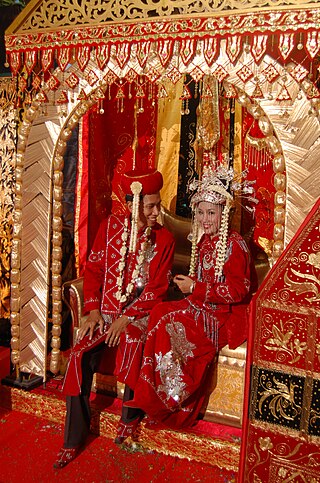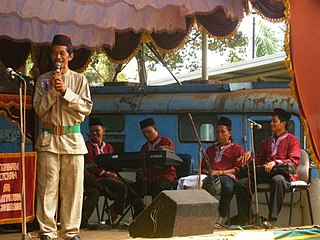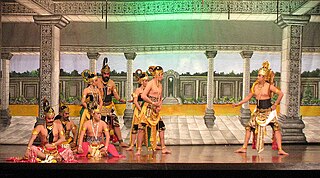
Betawi people, or Batavians, are an Austronesian ethnic group native to the city of Jakarta and its immediate outskirts, as such often described as the native inhabitants of the city. They are the descendants of the people who inhabited Batavia from the 17th century onwards.

Kroncong is the name of a ukulele-like instrument and an Indonesian musical style that typically makes use of the kroncong. A kroncong orchestra or ensemble traditionally consists of a flute, a violin, at least one, but usually a pair of kroncongs, a cello in Pizzicato style, string bass in pizzicato style, and a vocalist. Kroncong originated as an adaptation of a Portuguese musical tradition, brought by sailors to Indonesian port cities in the 16th century. By the late 19th century, kroncong reached popular music status throughout the Indonesian archipelago.

Kemayoran is a district (kecamatan) of Central Jakarta, Jakarta in Indonesia. It was best known for the former Kemayoran Airport and it has been transforming as a new central business district. As of 2023, it consists of numerous four and five-star hotels, restaurants, premium office towers, hospitals as well as shopping and entertainment centers. Kemayoran is also home to the Jakarta Fair, the largest and longest fair in Southeast Asia that attracts more than 4 million visitors annually.

Senen is a long-established urban district of Central Jakarta, Indonesia that has kept many tourist attractions such as two museums, the National Library of Indonesia, Gelanggang Remaja Senen, and narrow alleys with old Chinese and similar style shops and restaurants. It was first developed in the 18th century as Pasar Senen when Governor Daendels established the bovenstad as the new center of government of the fledgling city. Its core remains in what is now the lower-division Senen District, Kwitang, Kenari, Paseban, Kramat, and Bungur. Senen is bounded by a railway line to the east, Ciliwung River to the west, Pramuka Street to the south, and Abdul Rahman Saleh-Kwini II-Senen Raya IV Street to the north. The name is derived from Pasar Senen,.
Jagakarsa is the southernmost district in the administrative city of South Jakarta, Indonesia. Jagakarsa is bounded by Ciliwung River to the east, Krukut River to the west, and Margasatwa-Sagu-Joe-T.B.Simatupang-Poltangan Road to the north, while the boundary marches with Depok city to the south.

Cilincing is a historic neighborhood and administrative district (kecamatan) on the coast of North Jakarta Administrative City, Indonesia. It is sandwiched between the Port of Tanjung Priok to the west and River Titram to the east. Cilincing has been for some decades one of the districts of North Jakarta which in turn encompasses as far as Marunda and some non-coastal hinterland.

Setu Babakan Betawi Cultural Village or Setu Babakan is a cultural park of Betawi people, which is located at Srengseng Sawah, Jagakarsa, Jakarta in Indonesia. The village is about 5 kilometers southeast of Ragunan Zoo at the center of the Betawi Cultural Village, a site considered as part of the cultural heritage of Jakarta, which is devoted to the preservation of the indigenous Betawi culture. The location of the Betawi Cultural Village is replacement of the previous Condet (Betawi) Cultural Village which is eroded by the time.
Si Pitung was a 19th-century bandit in Batavia, Dutch East Indies. His exploits have since become legendary, with numerous accounts of his life, deeds, and death.

Djadoeg Djajakusuma was an Indonesian film director and promoter of traditional art forms. Born to a nobleman and his wife in Temanggung, Central Java, Djajakusuma became interested in the arts at a young age, choosing to pursue a career in theatre. During the Japanese occupation from 1943 to 1945 he was a translator and actor, and in the four-year national revolution which followed he worked for the military's educational division, several news agencies, and in drama.
Si Ronda is a 1930 silent film from the Dutch East Indies which was directed by Lie Tek Swie and starred Bachtiar Effendi. Based on contemporary Betawi oral tradition, it follows the exploits of a bandit, skilled in silat, known as Si Ronda. In the lenong stories from which the film was derived, Ronda was often depicted as a Robin Hood type of figure. The production, now thought lost, was one of a series of martial arts films released between 1929 and 1931. Si Ronda received little coverage in the media upon its release. A second adaptation of the tale, Si Ronda Macan Betawi, was made in 1978.

Gambang kromong is a traditional orchestra of Betawi people which is a blend of gamelan, Western music and Chinese-style pentatonic base tones. Gambang kromong is closely associated with the Chinese Betawi community, especially the Chinese Peranakan. It was popular in the 1930s.
Si Tjonat is a likely lost 1929 bandit film from the Dutch East Indies directed by Nelson Wong and produced by Wong and Jo Eng Sek. Based on the novel by F.D.J. Pangemanann, the silent film followed an indigenous man who, having killed his fellow villager, flees to Batavia and becomes a bandit. After kidnapping an ethnic Chinese woman, he is defeated and brought to justice.

Tjěrita Si Tjonat, Sato Kěpala Pěnjamoen di Djaman Dahoeloe Kala is a 1900 novel written by the journalist F. D. J. Pangemanann. One of numerous bandit stories from the contemporary Indies, it follows the rise and fall of Tjonat, from his first murder at the age of thirteen until his execution some twenty-five years later. The novel's style, according to Malaysian scholar Abdul Wahab Ali, is indicative of a transitional period between orality and written literature. Tjerita Si Tjonat has been adapted to the stage multiple times, and in 1929 a film version was made.
Frederick D. J. Pangemanann was a journalist and novelist from the Dutch East Indies.

The Luar Batang Mosque is one of the oldest mosques in Jakarta, Indonesia, located in the area of Pasar Ikan in North Jakarta on the west side of the Sunda Kelapa Harbor. The mosque was built in the 18th century and named after Luar Batang, in accordance with the nickname of a sacred guardian of Islam, Habib Luar Batang, where his shrine is also located.

Aminah Tjendrakasih was an Indonesian actress best known for her appearance as Lela in the television series Si Doel Anak Sekolahan. Beginning her career in her teenage years, Cendrakasih had her first starring role in 1955's Ibu dan Putri. She soared to popularity after taking a role in Serampang 12 along with Nun Zairina in 1956. Cendrakasih acted in more than a hundred feature films; in 2012 and 2013 she received Lifetime Achievement Awards from the Bandung Film Festival and the Indonesian Movie Awards.

Abdul Hamid Arief was an Indonesian actor who appeared in more than 120 films. Born in Batavia, Dutch East Indies, he started his acting career in theatre before migrating to film with 1948's Anggrek Bulan. His first starring role, and the one from which he first gained recognition, was as the title character in Pangeran Hamid. Over subsequent decades he was a productive film actor, often appearing in four or five films a year. He also acted in various television series.
Kemang is a neighborhood in southern part of Jakarta, Indonesia. The area is located mostly in Bangka subdistrict of Mampang Prapatan and partly within Pejaten subdistrict of Pasar Minggu. The main area of Kemang is marked by the roads of Kemang Raya, Prapanca, and Bangka Streets.

Tanjidor is a traditional Betawi musical ensemble developed in Jakarta, Indonesia. This musical ensemble took the form of a modest orchestra and was developed in the 19th century, pioneered by Augustijn Michiels better known as Major Jantje in the Citrap or Citeureup area on the outskirt of Batavia.

Indonesian theatre is a type of art in the form of drama performances that are staged on a stage, with a distinct Indonesian nuance or background. In general, theatre is an art that emphasizes the performing arts that are displayed in front of a large crowd. In other words, theater is a form of visualisation of a drama that is staged on the stage and watched by the audience. Indonesian theatre includes the performing arts of traditional theater and modern theatre located in the territory of Indonesia. Some examples of Indonesian theater are Arja, Wayang, Wayang wong, Lenong, Ludruk, Janger, Randai and others. Theatre in Indonesia can also be referred to as regional or ethnic theatre, because it originates and develops from 1,300 ethnic cultures in Indonesia.
















